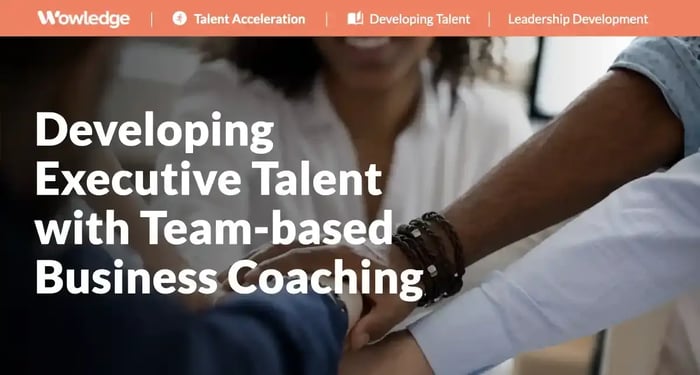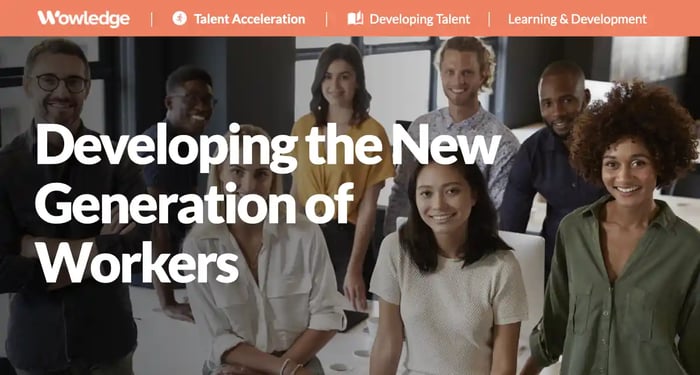Table of Contents
- The challenges when trying to build talent bench strength
- Who needs bench strength?
- Leveraging team-based business coaching
- The team-based business coaching process
- 1. Conduct an initial meeting and assessment of suitability for coaching
- 2. Call for a joint meeting with Management
- 3. Collect data
- 4. Assemble the coaching team
- 5. Perform one-to-one coaching
- 6. Videotape meetings
- 7. Make available related coaching materials
- 8. Establish a coaching plan
- 9. Spot coaching opportunities
- 10. Facilitate frequent meetings with management
- 11. Follow-up over telephone or virtual meeting
- 12. Conduct one-year evaluation
- In conclusion
- Relevant Practices & Tools
- FAQs
Let’s put words to what human resources professionals have known for a long time: When it comes to developing executive talent, a reliance on traditional training program approaches doesn’t work. In fact, except for using the classroom to transfer technical knowledge or expertise, the traditional approaches don’t successfully develop anyone—least of all executives. Team-based business coaching offers a solution.
Traditional training, where a teacher, facilitator, or other subject-matter expert works with a group of 8-20 people, hasn’t changed significantly in the past 60-plus years. Training methodologies may have evolved to a less didactic, higher-tech, and more participative approach, but the notion of teaching everyone in a room the same thing and expecting significant and enduring individual development is unrealistic—especially when it comes to developing the leadership talent needed to run your organization today and in the future.
The challenges when trying to build talent bench strength
Bench strength refers to the leadership talent waiting in the wings and needed to maintain and grow a business. It is critical to the long-term success of any organization—regardless of size or industry, yet the development and preparation of middle managers is often lacking. Unfortunately, most organizations don’t have the bench strength needed to step up to the plate and win the game in the event of unforeseen, or even planned, changes in executive management. All too often an organization completely overlooks the need to instill in its leadership the values, behaviors, and thinking skills required for future success. In all fairness, it’s easy to overlook or avoid executive development. There are seven key reasons contributing to the dilemma:
1. Executives don’t attend traditional training programs
When was the last time you saw someone at the senior management level or above attend a training program? They may go to seminars, conferences, or round tables to pick up ideas, but they don’t go to traditional training programs. Nor do they focus on their own development in a systematic way. If the executive development programs offered really work, then why do executives return to the office and have difficulty applying what was taught? Why do their behaviors change only incrementally, for brief periods, or not at all?
2. One size does not fit all
Learning to lead is not the same as learning to operate heavy machinery (although it may feel that way sometimes). Each leader has a unique set of development needs. Where Brian is great on the people side, he may falter when it comes to strategic planning. Or Kristen may exhibit top-notch skills in moving projects forward, but her heavy-handed approach makes it difficult to get talented people to work with her more than once. The traditional approach to training is to have people sit in a room for several days and have different topics paraded before them. Although Brian could certainly brush up on people skills, his time would be better spent learning about how executives think. Traditional training programs typically provide two or three facilitators with a wide variety of experiences. They’re broad enough to cover diverse subjects but are frequently jacks of all trades, masters of none.
3. Senior executives don’t expose their development needs in front of others
They tend to play it closer to the vest than lower-level staff members. Senior people feel at this stage of their careers they should know what they need to about leading the organization. This precludes them from asking for help in areas that may be their weak spots. Even when they do sit in on training programs, they are reluctant to ask the kinds of questions that would help them overcome their unique barriers to long-term success.
4. It’s lonely at the top
Much of what executives need to talk about to help them develop is confidential or privileged. There is no way they’re going to share that information in front of others. Take, for example, an executive who struggles with strategy and is currently debating whether or not to add a new service to the company’s product line. This presents the perfect opportunity to develop and enhance existing skills in strategic decision-making, but it won’t happen in a classroom.
5. Who’s going to tell the 8,000-pound gorilla to walk more softly?
Most senior people don’t ask for feedback from staff for fear of looking less powerful or inept. Some don’t even want to know what people think. On the other side is the problem of getting diluted feedback in response to genuine requests for feedback. When senior people do attend traditional training programs, facilitators are known to soft-soap their feedback for fear of losing a good client.
6. Leadership development takes time
Precisely because the leader has no tools with which to lead other than himself or herself, it takes time to identify the personal behaviors that require improvement, practice new skills, develop new behaviors, and see results. Mastering the complexities of leadership isn’t done in six months, let alone a week. Additionally, learning opportunities are constantly emerging—not during a one-week class. Many executives don’t know what they don’t know until they’re faced with having to know it. The best time to learn is when it can be practically applied in vivo.
7. Younger leaders want targeted learning
Generation X and Millennials have each proven that you don’t have to be with a company for a particularly long period of time to be promoted to a senior leadership position. These leaders want information quickly, they want it targeted, and they want it practical. They’re impatient with traditional classroom learning situations. They work and live life at a fast pace. Nothing is less appealing to them than the thought of sitting in a classroom for more than an hour or two.

Who needs bench strength?
You do. From Fortune 100 companies to professional services firms and nonprofit agencies, the pendulum has swung so far to the side of attracting technical (e.g., STEM) talent, that the need for leadership bench strength has taken a back seat. People talk about it—a lot. They put hundreds of thousands of dollars into orchestrating elaborate off-sites, establishing corporate universities, and sending people to executive development seminars without asking two very simple questions: (1) How do executives learn best, and (2) what are the desired measurable results?
If executives don’t learn from traditional approaches, especially when they are faced with the greatest challenges of their careers, then how can they provide the leadership necessary to sustain and grow the business? They are certainly not provided with the opportunity earlier in their careers - that is when most professionals establish themselves as subject matter experts. A well-established, but nonsensical, practice in most organizations is to reward such expertise with leadership responsibility. As people reach their peak in technical prowess, they’re moved into leadership positions.
Once there, the irony is that they are less likely to attend training programs for all the reasons stated above—and at the same time they most need development. The price paid for weak bench strength varies from organization to organization. An organization that had a strong leader for a period of time may find that when the leader leaves there isn’t the talent needed to maintain and further the organization’s success.
Organizations from nonprofits to Fortune 100 companies must ensure that the leadership talent is there when they need it. Some key indicators that you should be concerned about building in bench strength are:
- Your senior leadership team consists primarily of people within three to five years of retirement.
- You are a new CEO who wants to ensure the success of his or her top team.
- Your CEO is an entrepreneur ready to shift to a different role in your organization within the next 18 to 24 months. Your company is poised for further growth but has no infrastructure to support it.
- You have experienced high turnover unrelated to the job market.
- Your mid- and senior-level leaders are leaving the company due to either a lack of development opportunities or poor relationships with the top leaders.
- Your company has rapidly grown from an entrepreneurship or small organization to a larger one without developing the leadership needed to sustain growth.
Any of these scenarios would indicate the need for a focused effort in developing bench strength to support the changes that have or will take place. CEOs are often the people least likely to be concerned with bench strength. Ironically, what makes them successful—courage, confidence, determination, and high energy—are the same attributes that make them feel invincible or impervious to potential crises. If traditional training approaches don’t work to develop leaders—how can bench strength be developed?
Leveraging team-based business coaching
The answer lies partly in an age-old method used to develop virtuoso performers of any kind: one-to-one coaching with a team of professionals, each with a depth and breadth of expertise in a given area. Although coaching has been a management fad for the past five years or so, team-based business coaching is unique. It is based on the simple premise that no one coach can meet all of an executive’s training needs. Just as a baseball player is provided with multiple sources of coaching based on his unique needs (e.g., fielding coach, pitching coach, base running coach), executives often benefit from team-based business coaching, rather than a single coach.
The most typical development areas for new, and sometimes longer-tenured, executives are outlined in Figure 1. As you look through the list it should be apparent that a multitude of skills are needed to develop an executive in each of these areas.
Figure 1: Common Development Areas for Executives
| Development Area | Common Mistakes |
| Strategic thinking/planning | Too busy firefighting |
| Leadership | Controlling / low trust in others |
| Develop a strong senior team | Blind loyalty to cronies/cloning |
| Emotional intelligence | Low empathy Low self-awareness |
| Ego involvement | Won’t listen Won’t talk (share information) Know it all (sees no reason to change) |
| Interpersonal skills | Views them as “soft skills” – not integral to success Poor influence skills – gains compliance, not commitment Extremely introverted – poor social skills |
| Executive presence | Rambling Lacks the ability to inspire Lacks certitude |
| Work/life balance | Follows the myth of “success through hard work” Avoiding something at home (or not at home) |
Coaches who bring expertise in strategic thinking are not the same as those whose expertise is creating work/life balance or enhancing interpersonal skills—thus the value of team-based business coaching. And there’s another important factor at play—all coaches do not perform equally well with all executives. Because so much is riding on the relationship, it is important to have at least one member of the team with whom the executive relates well and whom they trust. There is a greater inclination to learn from the other coaches if they know that this one coach is on the team.
The team-based business coaching process
The team-based business coaching approach is simple. There are phases to be followed in the coaching that increase the likelihood of a successful engagement.
1. Conduct an initial meeting and assessment of suitability for coaching
There are three key elements of the assessment phase. First, not all executives are suitable candidates for coaching. A skilled business coach can assess in a relatively short time whether the projected results will warrant the investment. Common assessment factors include a lack of: desire, self-insight, candor, openness, an interest in learning, risk-taking, humility and general emotional health; if a number of these are present in the individual, they may not be good candidates for coaching.
A second consideration during the assessment phase is the “fit” between coaches and the executive. Does the team-based business coaching team have people who will relate well to this particular individual? Some executive teams are heavy into academic types—who typically do not fare well at all with, say, manufacturing people. Conversely, highly educated scientists want to work with people they respect from the outset—and these are often other highly educated, doctoral-level coaches.
Finally, what are the development areas for this person? Upon leaving the initial meeting, the assessor should be able to clearly target three to five key areas for development on which they and the executive agree.
2. Call for a joint meeting with Management
After the assessment has taken place and the executive agrees to work with the coaching team, there should be a meeting between the coaching team member, the executive, and their boss. This is for the purpose of ensuring that everyone is on the same page in terms of development areas and commitment to the process. It also precludes the coaching team from being the conduit of information between boss and executive. When this step is left out, a valuable opportunity to include the boss as an integral part of the process is missed. In essence, a verbal contract should be established as to what a successful engagement would look like.
3. Collect data
There are myriad methods for collecting data. The specific ones selected are not as important as ensuring they glean the information needed to hold up the mirror to the executive in an objective, nonbiased way. It’s not the coach or boss saying these areas need improvement, but rather a theme that runs through the data. Methods for data collection can include all or some of the following:
- Formal 360-degree feedback surveys via paper and pen or online.
- Brief E-mail survey’s that ask two or three questions relating to the executive’s leadership strengths and areas for development.
- Self-assessment tools (e.g., the Myers Briggs, NEO, FIRO-B, Wilson Learning).
- Interviews with key members of the executive’s network.
- Psychological assessment interview conducted by a licensed professional with strong expertise in executive development.
4. Assemble the coaching team
Once the data has been reviewed, then a team-based business coaching group can be assembled that complements the development needs of the executive. A coaching team typically consists of anywhere between two and four coaches, most often three. Each member of the team is provided with the data reports and clear directives about the areas on which to focus.
5. Perform one-to-one coaching
The executive can decide whether they want to work with one coach at a time or several simultaneously. In any case, the time commitment is typically no less than two to three hours every other week. It is also recommended that the coaching engagement be limited to six to eight months. When the engagement lasts longer than that, the executive has the tendency to postpone the coaching appointments. When it’s shorter than that, there isn’t sufficient time to engage in the depth or work required for significant and enduring change.
6. Videotape meetings
Individual sessions as well as presentations or meetings can be videotaped for the purpose of having the executive see how they come across. These are particularly valuable when executive presence is a development area.
7. Make available related coaching materials
Throughout the engagement, the executive should be provided with learning materials to complement the coaching. Whereas some executives prefer reading books, others prefer articles or audiotapes. The degree to which the executive actually reads the materials is a good indicator of commitment to the process.
8. Establish a coaching plan
Midway through the process, the coaching team prepares a written plan that includes specific and measurable coaching tips vis-à-vis development areas. Examples of these include (and are only applicable to a specific development need):
- Never be the first to speak in a meeting.
- Always speak within the first 15 minutes of any meeting.
- Chunk problems into five key categories for analysis.
- Hold staff meetings every week without fail.
- At least once a quarter, meet individually with each staff member to give and receive feedback.
- Develop a 25-word vision statement that describes the kind of leader you want to be.
- Have lunch or breakfast with different key constituents, internal and external, at least twice a month.
- Develop a weekly workout or exercise routine and stick to it religiously.
9. Spot coaching opportunities
Throughout the engagement, the executive should be encouraged to call members of the coaching team for on-the-spot coaching. For example, if he or she knows there will be a media presentation coming up, tips can be elicited for ensuring its success. Or, if an executive has an upcoming feedback session with an employee, he or she can role-play it with a coach. As the preestablished period of engagement settles in, such coaching can shift to telephone sessions.
10. Facilitate frequent meetings with management
Throughout the coaching engagement, the lead of the team-based coaching team should be contacting the executive’s manager to assess progress and areas for continued focus. These need not be long or frequent. However, at least midpoint and toward the end of the engagement, it is helpful to determine the degree to which the executive is engaging in the behaviors learned through the coaching process.
11. Follow-up over telephone or virtual meeting
Once the formal coaching has concluded, the coach should follow up with the executive to help iron out any wrinkles. It’s too easy to fall back into familiar patterns—these telephone follow-ups act as a reminder of the work done during the one-to-one meetings. Thus a period of three months or so of availability by the coach should be considered.
12. Conduct one-year evaluation
Approximately a year after the coaching commenced it can be helpful to collect follow-up feedback to measure progress. The hope, of course, is that those areas in which the executive was coached are rated more highly than initially. Sometimes it’s found that different areas appear for development. Once the obvious development needs are addressed, people sometimes begin to focus on other, higher-level development needs. These then present opportunities for continued growth and attention.
In conclusion
Developing bench strength for executives cannot happen soon enough or frequently enough during their careers. Once an employee has been identified as having high potential, they should immediately be targeted for assessment and team-based coaching. The early investment made in these future leaders pays huge dividends when talent is needed to replace executives who leave, support growth, or successfully deal with the many unexpected issues that arise during the course of normal business activities.
Relevant Practices & Tools
Core Leadership Development Practices to Define and Structure Leadership Capabilities. >
Leadership Development (LD) is the strategy and process of developing the key skills, capabilities, and styles needed by top leaders to successfully drive organizational performance... more »
Defining Leadership Competencies that Provide Consistent Benchmarks. >
The initial step is to define what will ultimately be the target for leaders' development. Competencies are clusters of job skills and behaviors that contribute to job success... more »
Tailoring Processes by Critical Role Segments to Address their Unique Needs and Preferences. >
At this level, performance management processes, criteria, and associated rewards are frequently tailored to specific talent segments and their unique needs... more »
Creating Group Coaching and Mentoring Programs to Broaden and Syndicate the Potential for Impact. >
As a coaching and mentoring culture progresses, its effect is felt throughout the organization. The key at this level is to syndicate the use of coaching and mentoring deeper... more »
The Manager Coaching Feedback Survey Tool: Define and Apply Basic Questions for Employees Providing Feedback on Managers' Coaching Prowess. >
Using this feedback survey tool helps assess the quality of line/functional managers’ coaching behaviors from their individual employees... more »
FAQs
How does team-based business coaching build leadership bench strength faster than traditional training?
Team-based coaching targets each executive’s specific gaps with specialists rather than broad content delivered to a cohort. Multiple coaches enable parallel skill-building in strategy, influence, and execution, reducing idle time between learning needs. Real work is used as the practice field, so behavior change is reinforced in the context of current business decisions. The approach compounds gains by pairing individualized feedback with visible results on live priorities.
What criteria should guide the selection and composition of a coaching team for an executive?
Selection should begin with validated development priorities and the contexts in which behaviors must change. Coaches are chosen for depth in those priorities, industry fluency, and demonstrated effectiveness at the target level. Complementary styles matter, so at least one coach serves as the trusted anchor, while others add specialized expertise. Conflicts of interest, availability, and cultural alignment should be screened before engagement.
How should measurable outcomes and ROI be defined for team-based business coaching?
Outcomes should tie to role-critical behaviors and business results, such as improved strategic execution, higher-quality decisions, enhanced credibility with subordinates and peers, or stronger succession readiness. Leading indicators include changes in stakeholder feedback, meeting effectiveness, and cycle times for key decisions. Lagging indicators can include internal fill rates for critical roles, retention of high potentials, and performance against growth or transformation milestones. ROI is assessed by comparing these gains to the combined cost of coaches and executive time.
How can team-based coaching accommodate Gen X and Millennial leaders’ preference for targeted, practical learning?
Design shorter, outcome-focused sessions with immediate application to current projects and stakeholders. Replace broad curricula with micro-interventions such as rehearsal for a critical meeting, decision frameworks, or negotiation drills. Provide asynchronous support via quick check-ins and on-demand feedback between sessions. Progress is tracked through concise scorecards that highlight behavior shifts rather than activity volume.










